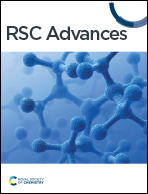Investigating the hydration of C3A in the presence of the potentially toxic element chromium–a route to remediation?†
Abstract
Pollution by hexavalent chromium is a growing, global problem. Its presence in public water systems is often the result of industrial activities, both past and present. In this study, tricalcium aluminate (C3A, Ca3Al2O6) is added to solutions of varying concentrations of potassium chromate (K2CrO4) and samples of both the solid and liquid are taken at various time intervals to monitor the removal of chromium from the solutions. Solution concentrations of 0.2 M, 0.1 M, 0.02 M, and 0.01 M are used, and the chromium concentration is found to reduce in all cases. For the 0.02 M solution the chromium concentration is reduced from 1040 ppm to 3.1 ppm in 1 week, and the chromium concentration of the 0.01 M solution is reduced from 520 ppm to 0.26 ppm in only one day of reaction with the C3A. The chromium removed from solution is identified in the solid products, which were fully characterised as being a mixture of ettringite (Ca6[Al(OH)6]2(CrO4)3·26H2O) and monochromate (Ca4[Al(OH)6]2CrO4·8H2O) phases from analysis of Powder X-ray Diffraction and Fourier Transform Infrared Spectroscopy data. The work presented here is a proof of concept study to investigate C3A as a potential material for the removal of hexavalent chromium from solution. The results from this study are initial steps towards development of this as a technology for hexavalent chromium remediation.



 Please wait while we load your content...
Please wait while we load your content...